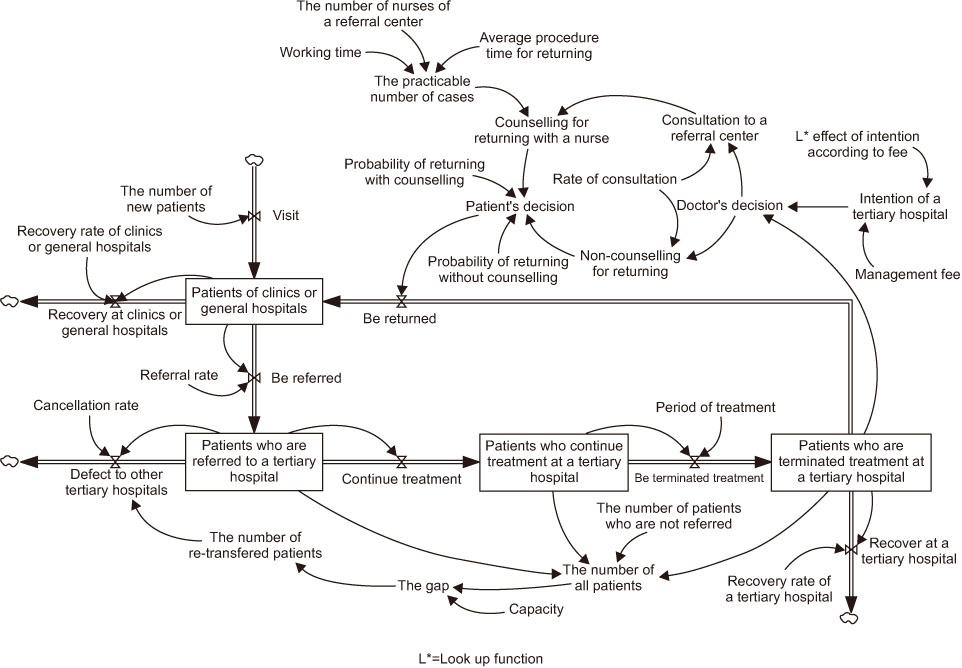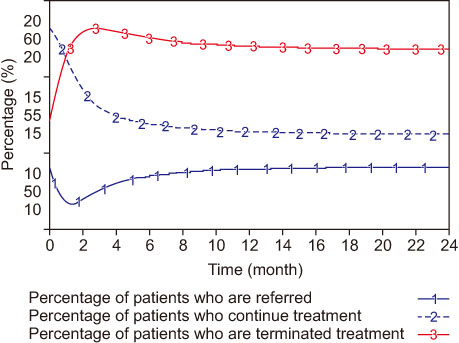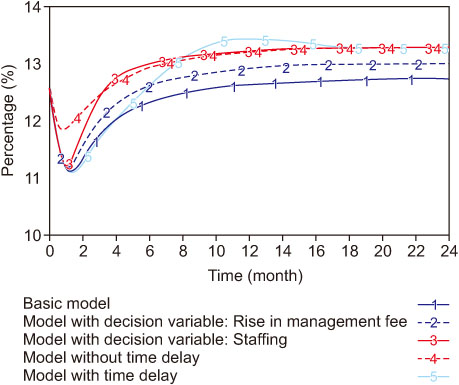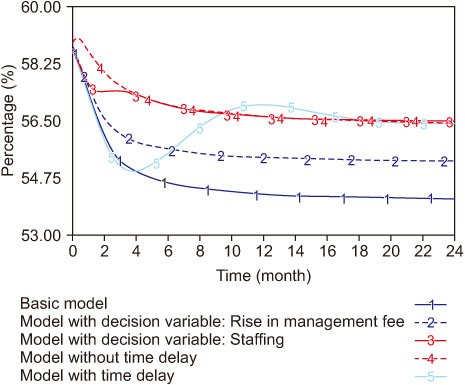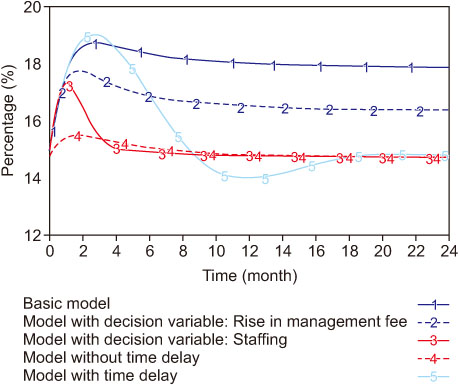J Korean Acad Nurs.
2018 Oct;48(5):554-564. 10.4040/jkan.2018.48.5.554.
Development and Analysis of System Dynamics Model for Predicting on the Effect of Patient Transfer Counseling with Nurses
- Affiliations
-
- 1College of Nursing Science, Kyung Hee University, Seoul, Korea.
- 2College of Nursing Science · East-West Nursing Research Institute, Kyung Hee University, Seoul, Korea. ekyun@khu.ac.kr
- KMID: 2424362
- DOI: http://doi.org/10.4040/jkan.2018.48.5.554
Abstract
- PURPOSE
This study aimed to construct a management model for patient transfer in a multilevel healthcare system and to predict the effect of counseling with nurses on the patient transfer process.
METHODS
Data were collected from the electronic medical records of 20,400 patients using the referral system in a tertiary hospital in Seoul from May 2015 to April 2017. The data were analyzed using system dynamics methodology.
RESULTS
The rates of patients who were referred to a tertiary hospital, continued treatment, and were terminated treatment at a tertiary hospital were affected by the management fee and nursing staffing in a referral center that provided patient transfer counseling. Nursing staffing in a referral center had direct influence on the range of increase or decrease in the rates, whereas the management fee had direct influence on time. They were nonlinear relations that converged the value within a certain period.
CONCLUSION
The management fee and nursing staffing in a referral center affect patient transfer counseling, and can improve the patient transfer process. Our findings suggest that nurses play an important role in ensuring smooth transitions between clinics and hospitals.
MeSH Terms
Figure
Reference
-
1. Organization for Economic Cooperation and Development (OECD). Health at a glance 2017: OECD indicators [Internet]. Paris: OECD Publishing;c2017. revised 2018 Feb. cited 2018 Sep 10. Available from: https://doi.org/10.1787/health_glance-2017-en.2. Yoon KJ, Ha SI, Yeo JY, Kim JH, Shin YS, Lee SH. Trends and issues for improvement of Korea healthcare delivery system. Seoul: Korea Institute for Health and Social Affairs;2014. 08. Report No.:2014-08-3.3. Kang HJ. Policy direction for decreasing the concentration of patients to extra-large hospitals. Health Welf Policy Forum. 2014; (210):65–76.4. Kim YK, Kim JS. A study on healthcare institution selection of healthcare consumers using theory of consumption values: Focusing on relations among clinics or small sized hospitals, general hospitals, and large-sized hospitals. J Korean Soc Qual Manag. 2009; 37(4):71–86.5. Lim JD, Jang HK, An MJ. Research on cooperative relationships between a university hospital and other medium-sized hospitals. J Korea Contents Assoc. 2009; 9(10):196–205. DOI: 10.5392/JKCA.2009.9.10.196.6. Shim GH, Moon KJ, Lee KS. Managerial efficiency & productivity growth analysis of tertiary and general hospitals in Korea: DEA & Malmquist productivity index model approach. Korean J Health Serv Manag. 2015; 9(3):43–55. DOI: 10.12811/kshsm.2015.9.3.043.7. Anderson S. Public, private, neither, both? Publicness theory and the analysis of healthcare organisations. Soc Sci Med. 2012; 74(3):313–322. DOI: 10.1016/j.socscimed.2011.07.021.
Article8. Goldstein SM, Naor M. Linking publicness to operations management practices: A study of quality management practices in hospitals. J Oper Manag. 2005; 23(2):209–228. DOI: 10.1016/j.jom.2004.07.007.
Article9. Health Insurance Review & Assessment Service (HIRA). The pilot project of referral in and out between hospitals built cooperative system [Internet]. Wonju: HIRA;c2017. cited 2018 Sep 10. Available from: https://www.hira.or.kr/bbsDummy.do?pgmid=HIRAA020002000100&brdScnBltNo=4&brdBltNo=6606.10. Health Insurance Review & Assessment Service (HIRA). 2016 The evaluation of healthcare quality [Internet]. Wonju: Health Insurance Review & Assessment service;c2016. cited 2018 Sep 10. Available from: https://www.hira.or.kr/bbsDummy.do?pgmid=HIRAA020002000100&brdScnBltNo=4&brdBltNo=5989.11. Ministry of Government Legislation (MOLEG). The criteria for designation of tertiary hospitals [Internet]. Sejong: MOLEG;c2017. cited 2018 Sep 10. Available from: http://www.law.go.kr.12. Kwon YJ. The plan of estimating medical fee based on patient's severity on tertiary hospitals [Internet]. Seoul: Seoul National University Hospital;c2018. cited 2018 Sep 10. Available from: http://bktimes.net/data/board_notice/1525078125-89.pdf.13. Joint Commission International (JCI). Joint Commission International accreditation standards for hospitals [Internet]. Version 4.0. Oakbrook Terrace (IL): Joint Commission on Accreditation of Healthcare Organizations;c2011. cited 2018 Sep 10. Available from: https://www.mintie.com/assets/pdf/education/JSI_4th_edition_standards.pdf.14. Nosbusch JM, Weiss ME, Bobay KL. An integrated review of the literature on challenges confronting the acute care staff nurse in discharge planning. J Clin Nurs. 2011; 20(5-6):754–774. DOI: 10.1111/j.1365-2702.2010.03257.x.
Article15. Donald F, Kilpatrick K, Reid K, Carter N, Bryant-Lukosius D, Martin-Misener R, et al. Hospital to community transitional care by nurse practitioners: A systematic review of cost-effectiveness. Int J Nurs Stud. 2015; 52(1):436–451. DOI: 10.1016/j.ijnurstu.2014.07.011.
Article16. Ashley C, Halcomb E, Brown A. Transitioning from acute to primary health care nursing: An integrative review of the literature. J Clin Nurs. 2016; 25(15-16):2114–2125. DOI: 10.1111/jocn.13185.
Article17. Han LL, Choi SM, Kim HJ, Kim SY, Kim HJ, Kang KJ. Transfer status analysis of referral center in a tertiary hospital. Asia Pac J Multimed Serv Converg Art Humanit Sociol. 2017; 7(11):537–551. DOI: 10.14257/ajmahs.2017.11.37.
Article18. Health Insurance Review & Assessment Service (HIRA). The evaluation of the pilot project of referral in and out between hospitals built cooperative system [Internet]. Wonju: HIRA;c2016. cited 2018 Sep 10. Available from: http://www.alio.go.kr/download.dn?fileNo=2231837.19. World Health Organization (WHO), Alliance for Health Policy and Systems Research. Systems thinking for health systems strengthening [Internet]. Geneva: WHO;c2009. cited 2018 Sep 10. Available from: http://www.who.int/alliance-hpsr/resources/9789241563895/en/.20. Marshall DA, Burgos-Liz L, IJzerman MJ, Osgood ND, Padula WV, Higashi MK, et al. Applying dynamic simulation modeling methods in health care delivery research-the SIMULATE checklist: Report of the ISPOR simulation modeling emerging good practices task force. Value Health. 2015; 18(1):5–16. DOI: 10.1016/j.jval.2014.12.001.
Article21. Lee H, Park ES, Yu JK, Yun EK. Non-linear system dynamics simulation modeling of adolescent obesity: Using Korea youth risk behavior web-based survey. J Korean Acad Nurs. 2015; 45(5):723–732. DOI: 10.4040/jkan.2015.45.5.723.
Article22. Jones AP, Homer JB, Murphy DL, Essien JD, Milstein B, Seville DA. Understanding diabetes population dynamics through simulation modeling and experimentation. Am J Public Health. 2006; 96(3):488–494. DOI: 10.2105/ajph.2005.063529.
Article23. Choi YH. Dynamic analysis of mindfulness and therapeutic relationship using system dynamics. Korean Syst Dyn Rev. 2016; 17(3):121–143.24. Rashwan W, Abo-Hamad W, Arisha A. A system dynamics view of the acute bed blockage problem in the Irish healthcare system. Eur J Oper Res. 2015; 247(1):276–293. DOI: 10.1016/j.ejor.2015.05.043.
Article25. Ansah JP, Eberlein RL, Love SR, Bautista MA, Thompson JP, Malhotra R, et al. Implications of long-term care capacity response policies for an aging population: A simulation analysis. Health Policy. 2014; 116(1):105–113. DOI: 10.1016/j.healthpol.2014.01.006.
Article26. Kwak CY. Application of system dynamics in nursing research. Korean Syst Dyn Rev. 2009; 10(4):73–83.27. Jang KS. A study on establishment of clinical career development model of nurses [dissertation]. Seoul: Yonsei University;2000. 1–201.28. Andersen RM. National health surveys and the behavioral model of health services use. Med Care. 2008; 46(7):647–653. DOI: 10.1097/MLR.0b013e31817a835d.
Article29. Gwak SM, You JG. System dynamics modeling and simulation. Seongnam: Book Korea;2016. p. 73–79.30. Ventana Systems. Vensim Software [computer Program]. Version 6.3D. Harvard (MA): Ventana Systems;2015. Available from: http://vensim.com/vensim-6-3d-released/.31. Eberlein RL, Peterson DW. Understanding models with Vensim™. Eur J Oper Res. 1992; 59(1):216–219. DOI: 10.1016/0377-2217(92)90018-5.
Article32. Barlas Y. Formal aspects of model validity and validation in system dynamics. Syst Dyn Rev. 1996; 12(3):183–210. DOI: 10.1002/(SICI)1099-1727(199623)12:3〈183::AID-SDR103〉3.0.CO;2-4.
Article33. Chung Y, Lim JM, Lee KJ. Systems thinking for the crisis and improvements of healthcare delivery system. Korean Syst Dyn Rev. 2016; 17(1):5–24.34. Kim SW. System thinking and scenario planning. 3rd ed. Cheongju: Publishing department of Chungbuk National University;2013. p. 249–279.35. Kim KH, Lee JC, Seo KH, Kim SY, Lee JS. The analysis of trend and improvement of healthcare delivery system. Seoul: Research Institute for Healthcare Policy;2015. 09. Report No.: 2015-2.36. Yang JW. A study on the effective process of health care delivery system through the fortified role of the referral center [master's thesis]. Seoul: Seoul National University;2006. 1–82.37. Kim KK. A study on the role identification of referral center nurses [master's thesis]. Suwon: Ajou University;2015. 1–57.38. Choi JS. Present situation of returned patients in a tertiary general hospital before and after commencement of the pilot project on referred and returned patients [master's thesis]. Seoul: Chung-Ang University;2018. 1–84.39. Wilkes L, Doull M, Paterson J, Cornu KL, Chok HN. The role of the general practice liaison nurse as integrated care coordinator: A Delphi study. Clin Nurs Stud. 2016; 4(3):67–77. DOI: 10.5430/cns.v4n3p67.
Article40. Kim DH, Moon TH, Kim DH. System dynamics. 2nd ed. Seoul: Daeyoung;2001. p. 52–54.41. Chaffee MW, McNeil MM. A model of nursing as a complex adaptive system. Nurs Outlook. 2007; 55(5):232–241. DOI: 10.1016/j.outlook.2007.04.003.
Article42. Shin H, Sung KM, Jeong SH, Kim DR. Trends of doctoral dissertations in nursing science: Focused on studies submitted since 2000. J Korean Acad Nurs. 2008; 38(1):74–82. DOI: 10.4040/jkan.2008.38.1.74.
Article
- Full Text Links
- Actions
-
Cited
- CITED
-
- Close
- Share
- Similar articles
-
- A Study on Counseling Experiences of Nurses of Infertility Centers Using a Qualitative Research Method
- Development of a Quantitative Model on Adolescent Cyberbullying Victims in Korea: A System Dynamics Approach
- The Focus Group Interview on Infertility Experts for the Development of Infertility Counseling System
- A Concept Analysis on Learning Transfer in Nursing Using the Hybrid Model
- The Development of an Organizational Socialization Process Model for New Nurses using a System Dynamics Approach

